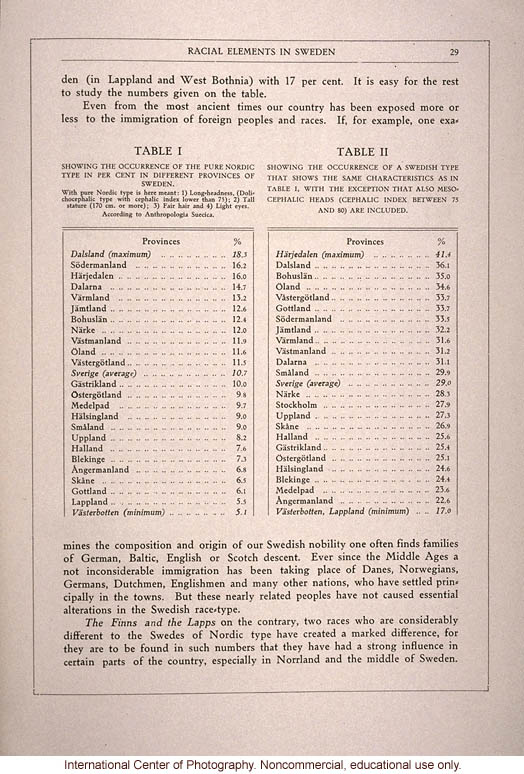[hairline boxed text]
Racial Elements In Sweden 29
[hairline score]
den (in Lappland and West Bothnia) with 17 per cent. It is easy for the rest to study the numbers given on the table.
Even from the most ancient times our country has been exposed more or less to the immigration of foreign peoples and races. If, for example, one examines the composition and origin of our Swedish nobility one often finds families of German, Baltic, English or Scotch descent. Ever since the Middle Ages a not inconsiderable immigration has been taking place of Danes, Norwegians, Germans, Dutchmen, Englishmen and many other nations, who have settled principally in the towns. But these nearly related peoples have not caused essential alterations in the Swedish race-type.
[italics]The Finns and the Lapps[end italics] on the contrary, two races who are considerably different to the Swedes of Nordic type have created a marked difference, for they are to be found in such numbers that they have had a strong influence in certain parts of the country, especially in Norrland and the middle of Sweden
[begin table]
TABLE I
Showing the Occurrence of the Pure Nordic Type in Per Cent in Different Provinces of Sweden.
With pure Nordic type is here meant: 1) Long-headedness(Dolichocephalic type with cephalic inches lower than 71); 2) Tall stature (170 cm. or more); 3) Fair hair and 4) Light eyes.
According to Anthropological Studies.
Provinces ......%
Dalsland (maximum)...18.3
Sodermanland...16.2
Harjedalen ... 16.0
Dalarna ... 14.7
Varmland ...13.2
Jamtland... 12.6
Bohuslan ...12.4
Narke ... 12.0
Vastmanland ...11.9
Oland ... 11.6
Vastergotland ... 11.3
Sverige (average) ...10.7
Gastrikland ... 10.0
Ostergotland ... 9.8
Medelpad ... 9.7
Halsingland ... 9.0
Smaland ... 9.0
Uppland ... 8.2
Halland ... 7.4
Blekinge ... 7.3
Angermanland ... 6.8
Skane ... 6.5
Gottland ... 6.1
Lappland ... 5.3
Vasterbotte (minimum) ...5.1[end table I]
[begin table]
TABLE II
Showing the occurrence of a Swedish type that shows the same characteristics as in Table I, with the exception that also mesocephalic heads (cephalic index between 75 and 80) are included.
Provinces.... %
Harjadalen (maximum) ... 41.4
Dalsland ... 36.1
Bohuslan ... 35.0
Oland ... 34.6
Vastergotland ... 33.7
Gottland ... 33.7
Sodermanland ...33.5
Jamtland ... 32.2
Varmland ... 31.4
Vastmanland ... 31.2
Dalarna ...31.1
Smaland ... 29.9
Sverige (average) ... 29.0
Narke ... 28.3
Stockholm ... 27.9
Uppland ... 27.3
Skane ... 26.9
Halland ... 25.6
Gastrikland ... 25.4
Ostergotland ... 25.1
Halsingland ... 24.6
Blekinge ... 24.4
Medelpad ... 23.4
Angermanland ... 22.4
Vasterbotten, Lappland (minimum) ... 17.0
[end table]
[end]


